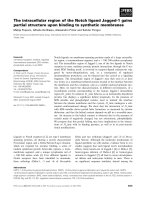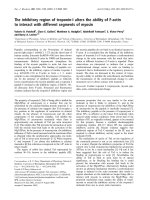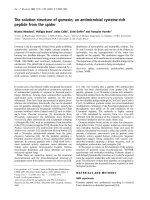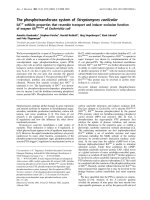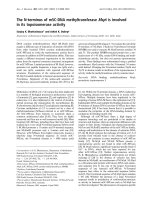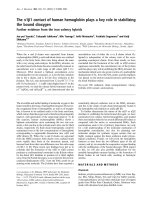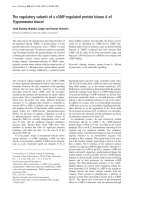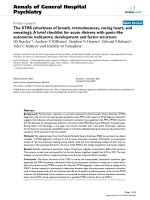Báo cáo Y học: The C-terminal region of ammodytoxins is important but not sufficient for neurotoxicity pot
Bạn đang xem bản rút gọn của tài liệu. Xem và tải ngay bản đầy đủ của tài liệu tại đây (187.65 KB, 6 trang )
PRIORITY PAPER
The C-terminal region of ammodytoxins is important but not
sufficient for neurotoxicity
Petra Prijatelj
1
, Igor Kriz
ˇ
aj
2
, Bogdan Kralj
3
, Franc Gubens
ˇ
ek
1,2
and Joz
ˇ
e Pungerc
ˇ
ar
2
1
Department of Chemistry and Biochemistry, Faculty of Chemistry and Chemical Technology, University of Ljubljana,
Ljubljana, Slovenia;
2
Department of Biochemistry and Molecular Biology and
3
Mass Spectrometry Center, Jozˇef Stefan Institute,
Ljubljana, Slovenia
Ammodytoxins (Atxs) are presynaptically acting snake
venom phospholipase A
2
(PLA
2
) toxins the molecular
mechanism of whose neurotoxicity is not completely
understood. Two chimeric PLA
2
s were prepared by repla-
cing the C-terminal part of a nontoxic venom PLA
2
,
ammodytin I
2
, with that of AtxA(K108N). The chimeras
were not toxic, but were able to bind strongly to an Atxs-
specific neuronal receptor, R25. They also showed an
increased affinity for calmodulin, a recently identified high-
affinity binding protein for Atxs, whereas affinity for a
neuronal M-type PLA
2
receptor remained largely un-
changed. The results show that the C-terminal region of
Atxs, which is known to be involved in neurotoxicity, is
critical for their interaction with specific binding proteins,
but that some other part of the molecule also contributes to
toxicity.
Keywords: calmodulin; neuronal receptor; phospholipase
A
2
; snake venom; toxicity.
Phospholipases A
2
(PLA
2
s, EC 3.1.1.4) constitute a diverse
superfamily of enzymes that catalyze the hydrolysis of the
sn-2 ester bond of phospholipids. They are divided into
intracellular (cytosolic) and extracellular (secreted) PLA
2
s.
Secreted PLA
2
s(sPLA
2
) are low molecular mass (13–
18 kDa), disulfide cross-linked (5–8 bonds) and Ca
2+
-
dependent enzymes [1–3]. They are typical interfacial
enzymes that access the substrate directly from the phos-
pholipid–water interface. In addition to enzymatic activity,
those that are found in animal venoms may also exhibit a
variety of pharmacological effects including neurotoxicity,
myotoxicity, cardiotoxicity, and anticoagulant and edema-
inducing activities [4].
Presynaptically neurotoxic sPLA
2
s of groups I and II are
the most potent toxins found in snake venoms, but the
molecular basis of their toxicity is not completely under-
stood [5]. It was shown that they first bind to several specific
binding sites (receptors) on the presynaptic membrane [6],
after which they are presumably endocytosed. In the nerve
cell, they may inhibit the recycling of synaptic vesicles by
binding to certain target proteins [7] and hydrolyzing certain
phospholipids [8], although no apparent correlation
between enzymatic activity and toxicity has been found
[9]. In the final stage of neurotoxicity, an irreversible
blockade of acetylcholine release at neuromuscular junc-
tions is observed [10].
Venom of the long-nosed viper (Vipera ammodytes
ammodytes) contains several group IIA sPLA
2
s. Ammody-
toxins (Atxs) are presynaptic sPLA
2
neurotoxins, ammo-
dytins (Atns) I
1
and I
2
are nontoxic sPLA
2
s, and AtnL is a
myotoxic but enzymatically inactive sPLA
2
homolog
[11–15]. Two receptors for Atxs with apparent molecular
masses of 25 kDa (R25) and 180 kDa (R180) have been
found in porcine cerebral cortex. R180 is an M-type sPLA
2
receptor located in the plasma membrane, that binds both
toxic and nontoxic sPLA
2
s of groups I and II [16,17]. R25 is
an intracellular receptor, specific for Atxs, whose identity is
still unknown [18]. During purification of R25, another
high-affinity binding protein for Atxs was isolated and
identified as calmodulin (CaM) [19], indicating that this
highly conserved, Ca
2+
-sensing regulatory molecule [20]
mayplayaroleinthesPLA
2
-neurotoxicity.
In our previous studies, we demonstrated that certain
residues in the C-terminal region of Atxs are involved in
both neurotoxicity and binding to neuronal receptors R25
and R180 [21–23]. Here we report a further investigation
of this relationship by preparing two chimeric proteins,
where the C-terminal region of nontoxic AtnI
2
was
substituted with that of highly neurotoxic AtxA. One of
the chimeras had an additional N24 fi F substitution in
the N-terminal region, as F24 is also found in AtxA. The
critical role of the C-terminal region of Atxs in binding to
R25 and CaM was confirmed. The two recombinant
proteins, however, remained nontoxic, indicating that this
region alone is not sufficient for the neurotoxic effect of
Atxs.
Correspondence to J. Pungerc
ˇ
ar, Department of Biochemistry
and Molecular Biology, Jozˇ ef Stefan Institute,
Jamova 39, SI-1000 Ljubljana, Slovenia.
Fax: + 38612573594, Tel.: + 38614773713,
E-mail:
Abbreviations: Atn, ammodytin; Atx, ammodytoxin; CaM,
calmodulin; PLA
2
, phospholipase A
2
; R180, an M-type PLA
2
receptor of 180 kDa; R25, Atxs-specific neuronal receptor of 25 kDa;
sPLA
2
, secreted PLA
2
.
Enzyme: phospholipase A
2
(EC 3.1.1.4).
(Received 6 September 2002, revised 30 September 2002,
accepted 10 October 2002)
Eur. J. Biochem. 269, 5759–5764 (2002) Ó FEBS 2002 doi:10.1046/j.1432-1033.2002.03301.x
EXPERIMENTAL PROCEDURES
Materials
AtnI
2
was isolated from Vipera a. ammodytes venom as
described [14]. Restriction enzymes were from MBI
Fermentas (Vilnius, Lithuania) and New England BioLabs.
Vent DNA polymerase, T4 polynucleotide kinase and Taq
DNA ligase were purchased from New England BioLabs.
T4 DNA ligase was obtained from Boehringer Mannheim.
Hog brain CaM was from Roche Molecular Biochemicals
and oligonucleotides from MWG-Biotech (Ebersberg,
Germany). Radioisotopes were obtained from PerkinElmer
Life Sciences, and disuccinimidyl suberate from Pierce
(Rockford, IL). All other chemicals were of analytical grade.
Construction of expression vectors
The coding sequences for both AtnI
2
/AtxA(K108N)
chimeric proteins were prepared by PCR using Vent DNA
polymerase. The N-terminal fragment, encoding the AtnI
2
part of the chimeras (N1–F106), was obtained by amplifying
AtnI
2
cDNA in pUC9 [14], using the sense oligonucleotide
5¢-ca
gga tcc atc gaa ggt cGG AAC CTT TAC CAG TTC
GGG-3¢ and the antisense oligonucleotide 5¢-cg taa aa
ctgc
agt tcg AAA GCA GAT TGC CGC GAC CC-3¢ (sequences
complementary to the template are in capital letters;
restriction sites BamHI, PstIandBstBI used for cloning
are underlined). The PCR product (325 bp) was excised from
a 1.7% (w/v) agarose gel, purified with GeneClean II
(BIO101, Vista, CA), digested with BamHI and PstI, and
ligated into pUC19. The BamHI/BstBI fragment (coding for
N1–F106 of AtnI
2
) was excised from this cloning vector and
inserted, together with the BstBI/HindIII fragment (coding
for Arg107–Cys133 of the mutant AtxA(K108N) (J. Pung-
erc
ˇ
ar, unpublished results), into the BamHI/HindIII-linea-
rized T7 promoter-based expression vector [21]. The coding
sequence for the N24F mutant of AtnI
2
/AtxA(K108N) was
obtained by PCR-directed mutagenesis using a known
method [24]. The outer sense primer 5¢-TAA TAC GAC
TCA CTA TAG-3¢, the outer antisense primer 5¢-GTT TAC
TCATATATACTTTAG-3¢ (both complementary to
plasmid DNA) and the inner sense primer introducing the
mutation, 5¢-TT TCC TAC AGC
TTT TAC GGA TGC-3¢
(the two nucleotides introducing mutation are underlined),
were used to amplify the AtnI
2
/AtxA(K108N)-encoding
expression plasmid. Two PCR products (391 bp and 565 bp)
were detected on a 1.7% (w/v) agarose gel. The larger DNA
fragment was purified from the gel, cleaved with BamHI and
HindIII, and the restriction fragment (399 bp) inserted into
the expression vector as above. The nucleotide sequences of
both constructs were confirmed using the ABI Prism 310
Genetic Analyzer (Perkin-Elmer Applied Biosystems). In
both cases, the expression vectors enabled production of the
two AtnI
2
/AtxA(K108N) chimeric sPLA
2
sasfusionpro-
teins with the N-terminal fusion peptide of 13 amino acid
residues (MARIRARGSIEGR).
Production and purification of recombinant proteins
Each of the two expression vectors was used to transform
the E. coli BL21(DE3) strain (Novagen, Madison, WI), and
the cells were grown at 37 °Cin5· 450 mL of LB-enriched
medium. When the optical density at 600 nm reached 2.0,
production of the recombinant proteins was induced by
isopropyl thio-b-
D
-galactoside and the incubation contin-
ued for an additional 3 h. Recombinant sPLA
2
swere
isolated as inclusion bodies, refolded in vitro, activated with
acetylated trypsin and purified by FPLC on a Mono S
column (HR 5/5; Pharmacia) as described [21,22]. The
AtnI
2
(N24F)/AtxA(K108N) mutant was additionally puri-
fied by reverse-phase HPLC.
Analytical methods
Protein sampleswereanalyzedby SDS/PAGEinthe presence
of 150 m
M
dithiothreitol on 15% polyacrylamide gels.
Reverse-phase HPLC was performed using an HP1100
system (Hewlett-Packard, Waldbronn, Germany) and an
Aquapore 300 BU column (30 · 4.6 mm) equilibrated with
0.1% (v/v) trifluoroacetic acid and eluted with a linear
gradient of 0–80% (v/v) acetonitrile. The N-terminal
sequence was determined by Edman degradation on an
Applied Biosystems Procise 492A protein sequencing system
(Foster City,CA). Electrosprayionization mass spectrometry
was performed on a high-resolution magnetic-sector Auto-
specQ mass spectrometer (Micromass, Manchester, UK).
Circular dichroism spectroscopy
CD spectra were recorded in the range of 250–200 nm at
25 °C on an Aviv 62A DS CD spectrometer. A bandwidth of
2 nm, a stepsize of 1 nm, and an averaging time of 2 s were
used. Protein concentrations were 15.2 l
M
for AtnI
2
/
AtxA(K108N), 16.5 l
M
for AtnI
2
(N24F)/AtxA(K108N)
and 33.3 l
M
for wild-type AtnI
2
. Protein water solutions
and water were scanned three times in a cell of 1 mm
pathlength, the spectra were then averaged and smoothed.
Binding studies
AtxC was radioiodinated [25] and membranes were extrac-
ted from a demyelinated crude mitochondrial-synaptosomal
fraction of porcine cerebral cortex as described [19]. The
membrane extract or CaM solution, 10 n
M
125
I-labeled
AtxC and increasing concentrations of unlabeled compet-
itor (mutant or wild-type sPLA
2
) were incubated at room
temperature for 30 min with occasional vortexing. Cross-
linking of sPLA
2
s to their binding proteins was achieved by
adding disuccinimidyl suberate dissolved in dimethylsulf-
oxide just before use, to a final concentration of 100 l
M
.
The reaction mixture was mixed vigorously for 5 min at
room temperature, and the cross-linking reaction stopped
by adding SDS/PAGE sample buffer containing dithiothre-
itol [19]. Following electrophoresis and autoradiography,
the intensities of the specific adducts on autoradiographs
were analyzed by QuantiScan (Biosoft, Cambridge, UK)
and the nonlinear curve fitting program
GRAFIT
, Version 3.0
(Erithacus Software, Staines, UK).
PLA
2
activity
Enzymatic activity was determined by a slightly modified
standard method using a micellar substrate [26]. Hydrolysis
of egg-yolk PtdCho was measured in a reaction mixture
(8 mL) supplemented with 1% (v/v) Triton X-100 and
5760 P. Prijatelj et al.(Eur. J. Biochem. 269) Ó FEBS 2002
15 m
M
CaCl
2
,atpH8.0and40°C. The fatty acids released
were titrated with 10 m
M
NaOH using a 718 STAT Titrino
pH-stat (Metrohm, Herisau, Switzerland). One enzyme unit
(U) corresponds to 1 lmol of hydrolyzed phospholipid per
minute.
Toxicity
Lethality was determined by intraperitoneal injection of
each sPLA
2
into NMRI albino mice. Just prior to appli-
cation, different doses of sPLA
2
s (2–360 lg) were prepared
in 0.5 mL of 0.9% (w/v) NaCl. LD
50
was determined after
24 h using a standard method [27]. The experiments on
mice were carried out in accordance with the EC Council
Directive regarding animal experimentation.
RESULTS
Construction of chimeric proteins
Both chimeric sPLA
2
s (Fig. 1A) were constructed to
substitute the 25 C-terminal amino acid residues in nontoxic
AtnI
2
with the corresponding 26 residues of neurotoxic
AtxA (AtnI
2
and AtxA are composed of 121 and 122 amino
acid residues, respectively). To ease the construction, the
AtxA-encoding fragment (R107-C133; amino acid number-
ing according to [28]) was obtained from the plasmid aimed
for expression of the AtxA(K108N) mutant, where, in
addition to this substitution, a silent mutation in the vicinity
introduced a unique BstBI restriction site at the F106 and
R107 codons suitable for cloning (J. Pungerc
ˇ
ar, unpub-
lished result). As a result, the two chimeric sPLA
2
sthatwe
prepared possess a single mutation (K108N) in the C-
terminal, AtxA-like region. As shown by the studies of the
AtxA double mutant (K108N/K111N) [21,22], the influence
of K108N substitution on neurotoxicity and protein-bind-
ing properties of AtxA was expected to be relatively small.
In one of the two chimeric proteins, N24 in the AtnI
2
-part
was substituted with F which is also present in neurotoxic
AtxA and plays an important role in the presynaptic
neurotoxicity of the toxin [29].
Bacterial production and characterization
of recombinant PLA
2
s
Recombinant sPLA
2
s produced in E. coli as N-terminal
fusion proteins were successfully activated by mild trypsi-
nolysis and purified to homogeneity as judged by SDS/
PAGE (Fig. 1B) and reverse-phase HPLC. The final yield
was approximately 2.6 mg and 0.7 mg per litre of bacterial
culture of AtnI
2
/AtxA(K108N) and its N24F mutant,
respectively. The single N-terminal amino acid sequence,
NLYQF…, of each recombinant chimera confirmed the
specific cleavage of the fusion protein during activation just
after the last R of the fusion peptide. The molecular masses
of chimeric proteins, determined by electrospray ionization
mass spectroscopy, 13.904 kDa for AtnI
2
/AtxA(K108N)
and 13.937 kDa for AtnI
2
(N24F)/AtxA(K108N), perfectly
match their theoretical values, assuming formation of all
seven disulfide bonds in the sPLA
2
molecule.
Influence of the mutations on the secondary structure and
overall conformation of the AtnI
2
molecule was analyzed by
CD spectroscopy. The far-UV CD spectra of both chimeric
sPLA
2
s and natural AtnI
2
were very similar (Fig. 1C)
indicating that the C-terminal region of AtxA, with the 14
residues differing from the corresponding AtnI
2
region
distributed mainly on the molecular surface (Fig. 2), did not
induce any substantial conformational changes in the
protein fold.
In contrast to wild-type AtnI
2
, both chimeric proteins
strongly inhibited binding of radiolabeled AtxC to the Atxs-
specific receptor, R25, with IC
50
values in the range of
20–24 n
M
, which is close to that of AtxA (Fig. 3A, Table 1).
The introduced C-terminal AtxA residues also enabled the
chimeric sPLA
2
s to bind to CaM. However, the interaction
of the chimeras with this high-affinity binding protein for
AtxA was considerably weaker than with AtxA (Fig. 3B,
Table 1). Binding of both chimeric proteins to R180 was
similar to that of AtnI
2
. No substantial difference was
observed between the two chimeras in regard to their
interaction with R25, R180 and CaM.
AtnI
2
/AtxA(K108N) showed only 50% of the wild-type
sPLA
2
activity on PtdCho–Triton X-100 mixed micelles.
When N24 was substituted by F, the specific enzymatic
activity of the chimera almost recovered to that of AtnI
2
.
The chimeric sPLA
2
s, at intraperitoneal doses 5–
10 mgÆkg
)1
, were not lethal to mice (Table 1).
Fig. 1. Alignment, SDS/PAGE and CD spectra of chimeric sPLA
2
s. (A)
Amino acid sequence alignment of chimeric sPLA
2
s with nontoxic
ammodytin I
2
(AtnI
2
) and neurotoxic ammodytoxin A (AtxA). The
common numbering of sPLA
2
residues is used [28] and gaps, shown by
dashes, are introduced to optimize alignment. Identical residues are
shown by dots. X represents N in AtnI
2
/AtxA(K108N) and F in
AtnI
2
(N24F)/AtxA(K108N). (B) SDS/PAGE of recombinant sPLA
2
s
after trypsin activation and purification. Lane 1, AtnI
2
/AtxA(K108N);
lane 2, its N24F mutant. Proteins (2 lg) were reduced by dithiothreitol
and stained with Coomassie Brilliant Blue R250. (C) CD spectra of
mutant and natural sPLA
2
s. The far-UV CD spectra of AtnI
2
/
AtxA(K108N) (short-dashed line) and AtnI
2
(N24F)/AtxA(K108N)
(long-dashed line) are compared with that ofwild-type AtnI
2
(solid line).
Ó FEBS 2002 Binding site of ammodytoxins for neuronal receptors (Eur. J. Biochem. 269) 5761
DISCUSSION
It has been demonstrated that Atxs, the presynaptically
neurotoxic sPLA
2
s from venom of the long-nosed viper,
strongly and specifically bind to neuronal receptor R25 and
CaM [18,19]. No binding to these proteins was observed
with AtnI
2
, a nontoxic sPLA
2
from the same venom, which
differs from Atxs in more than 40% of amino acid residues.
The two chimeric sPLA
2
s(AtnI
2
/AtxA(K108N) and
AtnI
2
(N24F)/AtxA(K108N)), prepared in this study on a
nontoxic AtnI
2
-scaffold, still differ from Atxs in about 30%
of residues, but were able to interact with both Atx-binding
proteins. The ability of the chimeric proteins to inhibit
125
I-labeled AtxC binding to R25 was practically at the level
of wild-type AtxA, indicating the crucial role of the last 26
amino acid residues of AtxA for this interaction. This is in
accordance with our previous results, which suggested that
specifically distributed positively charged amino acid resi-
dues, and particular hydrophobic and aromatic residues on
the surface (residues 115–124) in the C-terminal region of
Fig. 2. Location of the mutated residues in chimeric sPLA
2
s. The
polypeptide backbone is shown in line ribbon representation and the
residues introduced into AtnI
2
resulting in the chimeric proteins in
CPK (spacefilling) representation. The figure was generated using
WebLab
VIEWERLITE
software (Molecular Simulations, Cambridge,
UK).
Fig. 3. Competition of different sPLA
2
s for the binding of
125
I-labeled
AtxC to high-affinity binding proteins. R25 (A) or CaM (B) were
incubated with labeled AtxC in the presence of increasing concentra-
tions of AtxA (s), AtnI
2
/AtxA(K108N) (d), AtnI
2
(N24F)/
AtxA(K108N) (h)andAtnI
2
(n) to inhibit affinity labeling. The
radioactivity of the
125
I-labeled AtxC-binding protein adduct is shown
relative to that in the absence of any competitor.
Table 1. Binding properties, enzymatic activity and toxicity of chimeric sPLA
2
s. IC
50
values are mean ± S.E.M. of at least three independent
measurements. The enzymatic activity values are accurate to within ± 10%.
sPLA
2
IC
50
(n
M
)
Specific enzymatic
activity (UÆmg
)1
)LD
50
(lgÆkg
)1
)
R25 CaM R180
AtxA 10 ± 3
a
6±2
a
16 ± 3
a
280
b
21
b
AtnI
2
>10
4
>10
4
610 ± 100 880 >10
4
AtnI
2
/AtxA(K108N) 20 ± 6 1300 ± 200 490 ± 100 440 >10
4
AtnI
2
(N24F)/AtxA(K108N) 24 ± 6 1700 ± 300 850 ± 200 840 >5000
a
[29],
b
[12].
5762 P. Prijatelj et al.(Eur. J. Biochem. 269) Ó FEBS 2002
neurotoxic Atxs are involved in binding to this receptor
[22,23]. The C-terminal region of Atxs, however, is not
critically involved in binding to R180, as the binding
affinities of AtnI
2
and both chimeras for this M-type sPLA
2
receptor were similar. This is also in line with the proposed
structural elements of sPLA
2
s, mainly located in or close to
the Ca
2+
-binding loop, that are involved in binding to
M-type sPLA
2
receptors [30].
It appears that the binding site for R25, located in the
C-terminal region of Atxs, at least partially overlaps with
that for CaM. Since the binding affinities of the two
chimeric sPLA
2
s for CaM are still considerably lower than
that of AtxA, we assume that amino acid residues from
some other region of Atxs, which are spatially close to the
C-terminal residues contribute to this interaction. Substitu-
tion of N24 by F in the second chimera did not significantly
influence binding to each of the three Atxs-binding proteins.
A similar, small effect on binding affinity for these proteins
was also observed by the reverse mutation (F24N) of AtxA,
although in that case lethality of the toxin was dramatically
decreased [29]. However, the replacement of N24 by F in
this study did not result in higher toxicity of the construct;
only the enzymatic activity on PtdCho–Triton X-100 mixed
micelles increased twofold. The increase in enzymatic
activity of the N24F chimera was expected, since the residue
at position 24 is a constitutive part of the interfacial binding
surface, important for adsorption of sPLA
2
s to aggregated
phospholipid substrates, such as membranes, vesicles and
micelles [31,32]. In certain cases, as shown by a study of
human group IIA sPLA
2
[33], even the introduction of a
single aromatic (F) residue to this surface may considerably
increase binding, particularly to aggregated zwitterionic
(e.g. PtdCho) substrates. The higher enzymatic activity of
the N24F chimera is also in agreement with the behavior of
the AtxA(F24N) mutant, where the reverse substitution
(F24N) resulted in fourfold lower enzymatic activity [29].
Our previous studies have demonstrated the importance
for neurotoxicity of the C-terminal region stretching over
the top of the Atx molecule (Fig. 2), particularly certain
hydrophobic/aromatic and basic residues [21–23]. The same
region is also involved in the high-affinity binding of these
toxins to R25 and CaM. In contrast to AtnI
2
, both AtnI
2
/
AtxA(K108N) chimeric proteins were able to bind to these
AtxA-binding proteins, but were not toxic. Our results show
that F24 and the last 26 amino acid residues of potently
neurotoxic AtxA are not enough to transform a nontoxic
sPLA
2
into a neurotoxic one. It is evident that some other
residues on the toxin molecule also contribute to produce
the neurotoxic effect.
ACKNOWLEDGEMENTS
TheauthorswouldliketothankDrTadejMalovrhforhelpinlethality
measurements and Dr Roger H. Pain for critical reading of the
manuscript. This work was supported by grant P0-0501-0106 from the
Slovenian Ministry of Education, Science and Sport.
REFERENCES
1. Six, D.A. & Dennis, E.A. (2000) The expanding superfamily of
phospholipase A
2
enzymes: classification and characterization.
Biochim. Biophys. Acta – Mol. Cell. Biol. Lipids 1488, 1–19.
2. Berg, O.G., Gelb, M.H., Tsai, M.D. & Jain, M.K. (2001) Inter-
facial enzymology: the secreted phospholipase A
2
-paradigm.
Chem. Rev. 101, 2613–2654.
3. Scott, D.L. (1997) Phospholipase A
2
: structure and catalytic
properties. In Venom Phospholipase A
2
Enzymes: Structure,
Function and Mechanism (Kini, R.M., ed.), pp. 97–128. John Wiley
& Sons, Chichester, UK.
4. Kini, R.M. (1997) Phospholipase A
2
– a complex multifunctional
protein puzzle. In Venom Phospholipase A
2
Enzymes: Structure,
Function and Mechanism (Kini, R.M., ed.), pp. 1–28. John Wiley &
Sons, Chichester, UK.
5. Gubens
ˇ
ek, F., Krizˇ aj,I.&Pungerc
ˇ
ar, J. (1997) Monomeric
phospholipase A
2
neurotoxins. In Venom Phospholipase A
2
Enzymes: Structure, Function and Mechanism (Kini, R.M., ed.),
pp. 245–268. John Wiley & Sons, Chichester, UK.
6. Chang, C.C. & Su, M.J. (1980) Mutual potentiation, at nerve
terminals, between toxins from snake venoms which contain
phospholipase A activity: b-bungarotoxin, crotoxin, taipoxin.
Toxicon 18, 641–648.
7. Krizˇ aj, I. & Gubens
ˇ
ek, F. (2000) Neuronal receptors for phos-
pholipases A
2
and b-neurotoxicity. Biochimie 82, 807–814.
8. Montecucco, C. & Rossetto, O. (2000) How do presynaptic
PLA
2
neurotoxins block nerve terminals? Trends Biochem. Sci. 25,
266–270.
9. Lambeau,G.,Barhanin,J.,Schweitz,H.,Qar,J.&Lazdunski,M.
(1989) Identification and properties of very high affinity brain
membrane-binding sites for a neurotoxic phospholipase from the
taipan venom. J. Biol. Chem. 264, 11503–11510.
10. Chang, C.C. (1985) Neurotoxins with phospholipase A
2
activity in
snake venoms. Proc.NatlSci.Counc.BROC9, 126–142.
11. Gubens
ˇ
ek, F., Ritonja, A., Zupan, J. & Turk, V. (1980) Basic
proteins of Vipera ammodytes venom. Studies of structure and
function. Period. Biol. 82, 443–447.
12. Thouin, L.G., Jr, Ritonja, A., Gubens
ˇ
ek, F. & Russell, F.E. (1982)
Neuromuscular and lethal effects of phospholipase A from Vipera
ammodytes venom. Toxicon 20, 1051–1058.
13. Lee, C.Y., Tsai, M.C., Chen, Y.M., Ritonja, A. & Gubens
ˇ
ek, F.
(1984) Mode of neuromuscular blocking action of toxic
phospholipases A
2
from Vipera ammodytes venom. Arch. Int.
Pharmacodyn. Ther. 268, 313–324.
14. Krizˇ aj, I., Liang, N S., Pungerc
ˇ
ar, J., S
ˇ
trukelj, B., Ritonja, A. &
Gubens
ˇ
ek, F. (1992) Amino acid and cDNA sequences of a
neutral phospholipase A
2
from the long-nosed viper (Vipera
ammodytes ammodytes)venom.Eur. J. Biochem. 204, 1057–1062.
15. Krizˇ aj, I., Bieber, A.L., Ritonja, A. & Gubens
ˇ
ek, F. (1991) The
primary structure of ammodytin L, a myotoxic phospholipase A
2
homologue from Vipera ammodytes venom. Eur. J. Biochem. 202,
1165–1168.
16. C
ˇ
opic
ˇ
,A.,Vuc
ˇ
emilo, N., Gubens
ˇ
ek, F. & Krizˇ aj, I. (1999) Iden-
tification and purification of a novel receptor for secretory
phospholipase A
2
in porcine cerebral cortex. J. Biol. Chem. 274,
26315–26320.
17. Vardjan, N., Sherman, N.E., Pungerc
ˇ
ar, J., Fox, J.W.,
Gubens
ˇ
ek,F.&Krizˇ aj, I. (2001) High-molecular-mass receptors
for ammodytoxin in pig are tissue-specific isoforms of M-type
phospholipase A
2
receptor. Biochem. Biophys. Res. Commun. 289,
143–149.
18. Vuc
ˇ
emilo, N., C
ˇ
opic
ˇ
,A.,Gubens
ˇ
ek, F. & Krizˇ aj, I. (1998) Identifica-
tion of a new high-affinity binding protein for neurotoxic phos-
pholipases A
2
. Biochem. Biophys. Res. Commun. 251, 209–212.
19. S
ˇ
ribar, J., C
ˇ
opic
ˇ
,A.,Paris
ˇ
, A., Sherman, N.E., Gubens
ˇ
ek, F., Fox,
J.W. & Krizˇ aj, I. (2001) A high affinity acceptor for phospholipase
A
2
with neurotoxic activity is a calmodulin. J. Biol. Chem. 276,
12493–12496.
20. Chin, D. & Means, A.R. (2000) Calmodulin: a prototypical
calcium sensor. Trends Cell Biol. 10, 322–328.
Ó FEBS 2002 Binding site of ammodytoxins for neuronal receptors (Eur. J. Biochem. 269) 5763
21. Pungerc
ˇ
ar, J., Krizˇ aj, I., Liang, N S. & Gubens
ˇ
ek, F. (1999)
An aromatic, but not a basic, residue is involved in the toxicity
of group-II phospholipase A
2
neurotoxins. Biochem. J. 341,139–
145.
22. Prijatelj, P., C
ˇ
opic
ˇ
, A., Krizˇ aj, I., Gubens
ˇ
ek,F.&Pungerc
ˇ
ar, J.
(2000) Charge reversal of ammodytoxin A, a phospholipase
A
2
-toxin, does not abolish its neurotoxicity. Biochem. J. 352,251–
255.
23. Ivanovski, G., C
ˇ
opic
ˇ
, A., Krizˇ aj, I., Gubens
ˇ
ek,F.&Pungerc
ˇ
ar, J.
(2000) The amino acid region 115–119 of ammodytoxins plays an
important role in neurotoxicity. Biochem. Biophys. Res. Commun.
276, 1229–1234.
24. Michael, S.F. (1994) Mutagenesis by incorporation of a phos-
phorylated oligo during PCR amplification. Biotechniques 16,
410–412.
25. Krizˇ aj, I., Dolly, J.O. & Gubens
ˇ
ek, F. (1994) Identification of the
neuronal acceptor in bovine cortex for ammodytoxin C, a pre-
synaptically neurotoxic phospholipase A
2
. Biochemistry 33,
13938–13945.
26. Dennis, E.A. (1973) Kinetic dependence of phospholipase A
2
activity on the detergent Triton X-100. J. Lipid Res. 14, 152–159.
27. Reed,L.J.&Muench,H.(1938)Asimplemethodofestimating
fifty per cent endpoints. Am. J. Hygiene 27, 493–497.
28. Renetseder, R., Brunie, S., Dijkstra, B.W., Drenth, J. & Sigler,
P.B. (1985) A comparison of the crystal structures of phospho-
lipase A
2
from bovine pancreas and Crotalus atrox venom. J. Biol.
Chem. 260, 11627–11634.
29. Petan, T., Krizˇ aj, I., Gubens
ˇ
ek, F. & Pungerc
ˇ
ar, J. (2002) Phe-
nylalanine-24 in the N-terminal region of ammodytoxins is
important for both enzymic activity and presynaptic toxicity.
Biochem. J. 363, 353–358.
30. Lambeau, G., Ancian, P., Nicolas, J.P., Beiboer, S.H., Moinier,
D., Verheij, H. & Lazdunski, M. (1995) Structural elements of
secretory phospholipases A
2
involved in the binding to M-type
receptors. J. Biol. Chem. 270, 5534–5540.
31. Dijkstra, B.W., Drenth, J. & Kalk, K.H. (1981) Active site and
catalytic mechanism of phospholipase A
2
. Nature 289, 604–606.
32. Steiner, R.A., Rozeboom, H.J., de Vries, A., Kalk, K.H.,
Murshudov, G.N., Wilson, K.S. & Dijkstra, B.W. (2001) X-ray
structure of bovine pancreatic phospholipase A
2
at atomic
resolution. Acta Cryst. Sect. D 57, 516–526.
33. Baker, S.F., Othman, R. & Wilton, D.C. (1998) Tryptophan-
containing mutant of human (group IIa) secreted phospholipase
A
2
has a dramatically increased ability to hydrolyze phosphati-
dylcholine vesicles and cell membranes. Biochemistry 37, 13203–
13211.
5764 P. Prijatelj et al.(Eur. J. Biochem. 269) Ó FEBS 2002
